A History of the County of Hampshire: Volume 4. Originally published by Victoria County History, London, 1911.
This free content was digitised by double rekeying. All rights reserved.
'The borough of Lymington', in A History of the County of Hampshire: Volume 4, ed. William Page( London, 1911), British History Online https://prod.british-history.ac.uk/vch/hants/vol4/pp639-649 [accessed 28 November 2024].
'The borough of Lymington', in A History of the County of Hampshire: Volume 4. Edited by William Page( London, 1911), British History Online, accessed November 28, 2024, https://prod.british-history.ac.uk/vch/hants/vol4/pp639-649.
"The borough of Lymington". A History of the County of Hampshire: Volume 4. Ed. William Page(London, 1911), , British History Online. Web. 28 November 2024. https://prod.british-history.ac.uk/vch/hants/vol4/pp639-649.
In this section
LYMINGTON BOROUGH
Lentune (xi cent.); Leminton, Lyminton, Lymington (xiii cent.).
The quiet town of Lymington lies on the western bank of the Lymington River, about 2 miles from the Solent. The mud flats lining the little creek lie exposed except at high tide, and behind them is a level sweep of land rising to the west; the town stretches from the river up the hill. The original borough would seem to have been a strip of land lying by the river bank and its wharf, and probably included the High Street and the land to the south. In evidence of this it would appear that when the borough boundaries were extended in the middle of the 13th century the 'extension' lay on the north side of the church, which lies at the west end of the High Street, a long wide way leading up the hill at right angles to the stream. Here there are still some houses with good 18th-century fronts, but the old Town Hall has gone, (fn. 1) and with it the Blind House and the permanent booths that stood in a row down the middle of the street. Here must have stood in 1675 the 'Nagg's Head,' the 'George,' the 'White Lion' and the 'Bugle' (fn. 2) —one of them doubtless that tavern at which scandal said the vicar of Boldre played tables one day while the congregation vainly waited in church for evensong. (fn. 3) Parallel to the High Street on either side there ran a lane, each connected with the main road by a transverse way crossing just above the Town Hall. Probably the original Town Hall was that belonging to the manor, and described in 1299–1300 as 'the hall with a garden containing ½ acre,' and worth 7s. per annum saving repairs. (fn. 4) In the reign of Edward III it was spoken of as a house with a little close used for holding courts, and worth nothing beyond repairs. (fn. 5) In the 17th century the hall had come to be regarded as the property of the burgesses, but it was admitted that the courts of the lord were always held there. (fn. 6) In the section thus formed to the south lay Holme's Mead, belonging to the town and let in 1676 for 17s. (fn. 7) Just east of it lay the land of Christchurch Priory, and across the road and to the south was a piece of land known as Flushard at the close of the 17th century, and probably identical with the three closes called Fleshetts in the tenure of John Pope in 1589–90. (fn. 8) Possibly here, too, may have been 'the lord's mead.' (fn. 9) Both these plots of land, however, seem to have been in the manor of Old Lymington and without the limits of the borough which was contained in 'the Hundred Acres.' Within this 'Hundred Acres' was the Barfield, commonable land, on which the lord of Buckland had the right of 'breach' with ten kine and a bull. (fn. 10) North of Barfield was Buckland Hill, with further common and a pound wherein the stray cattle of New Lymington folk were confined. (fn. 11) Some of the waste of the manor was inclosed by John Long in or about 1609, but part was still uninclosed in that year, and on it was a certain green hill thought to be butts and a 'summer bugg' (fn. 12) and a cross where the farmers of Buckland 'at the time of the procession kept drinking.' (fn. 13) The earthwork known as Buckland Rings was probably part of this waste. (fn. 14) On the lower ground there was a water-mill in 1340 belonging to the fee of Buckland, (fn. 15) and in 1299–1300 there was at Peisford a second mill, held by tenants paying a yearly rent of 1 lb. of pepper. (fn. 16)
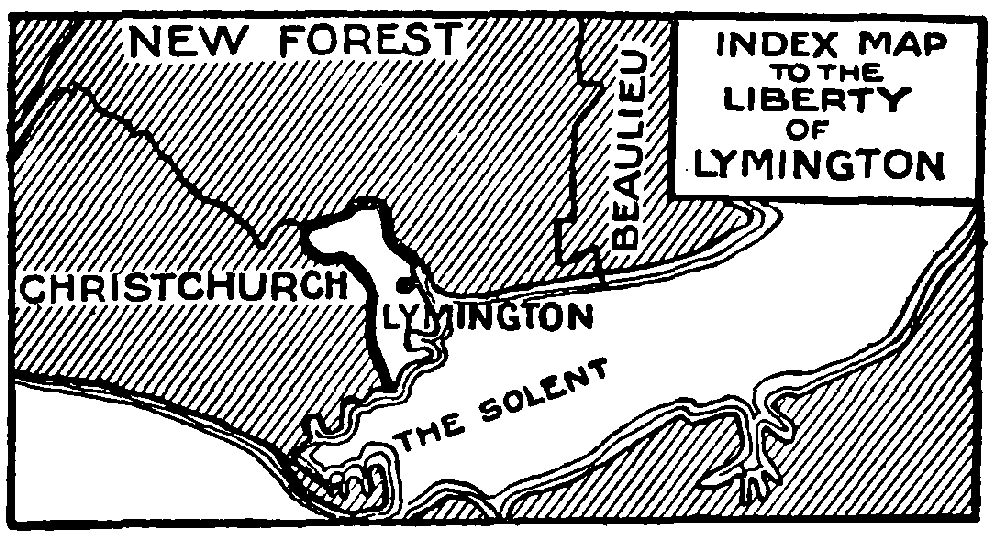
Index Map to the Liberty of Lymington
Lymington has never played any notable part in the affairs of the kingdom at large, though, according to tradition, it has been thrice burnt in French raiding expeditions. In spite of its mud flats it was said to be growing into some repute as a wateringplace in 1778, (fn. 17) and baths were erected in about 1830. In the Boundary Commission Report of 1831, however, the commissioners did not give a hopeful prospect for the borough. From the general appearance of the town, the absence of manufactures and trade and its unfitness as a bathingplace there was no likelihood of any considerable addition in the number of houses, of which there were then 427, only 232 being worth £10 a year. The inhabitants were chiefly tradesmen 'of a middling description,' and there were only 260 ratepayers. The present yacht-building industry dates from about this time, (fn. 18) and Lymington is now, perhaps, best know n as a harbouragefor those yachting in the Solent. But if Lymington has never been famous for political events it has latterly had several well-known persons connected with it in various ways. William Allingham held an office in the customs here; Coventry Patmore lived here from 1891 until his death in 1896; Henry Francis Lyte, the author of the hymns 'Abide with me' and 'Pleasant are Thy courts above,' held the curacy here, and here wrote many of his works. (fn. 19) Its nearness to Portsmouth made it in the 18th and 19th centuries, as now, a favourite place for naval officers to make a home.
The parish of Lymington contains the manors of Old and New Lymington and the borough of New Lymington. In 1086 the manor of Old Lymington with its vill alone existed, (fn. 20) and no mention is made in the Domesday Survey of the salterns here that in 1147 were already important. (fn. 21) About a century later the vill was so prosperous that a fresh extent of the manor was made and the rent of the tenants increased by 10s. 9d. (fn. 22); apart from the salterns, some of which were held in villeinage and some in demesne, (fn. 23) the accounts of the reeve of the manor in 1269–70 present the usual items of a rural community. (fn. 24) At what date the manor of New Lymington was formed is not known, but the mesne borough on the river bank probably came into being in the 12th century, (fn. 25) and owed its origin to the proximity of the salterns and the conveniences of the wharfage for the light ships of the time. The prosperity of the settlement must have increased rapidly, for by the middle of the 13th century Baldwin de Redvers extended the limits of the borough, (fn. 26) so that from this time it was comprehended within 'the Hundred Acres' and was practically conterminous with the manor of New Lymington. (fn. 27) The boundaries were not, however, defined until 1795, (fn. 28) and as late as 1847 certain tenements within the borough area were assessed not in it but in the manor. This fact was well known in 1833, when tradition had it 'that at some early period, on an incursion of some French, a great part of the then town was burnt, that what remained became incorporated as a borough, and that all tenements erected after the incorporation, unless erected upon the site of tenements standing at the time of incorporation, or upon ground attached to such tenements, are exclusive of the borough.' (fn. 29) Moreover, by the charter of 1271 the two tenements of the Abbot of Beaulieu were expressly excluded from participation in the liberties and acquittances of the borough. (fn. 30) It was doubtless concerning these two tenements that a dispute arose at the beginning of the 14th century (fn. 31) between the abbey and the borough over tolls; in the end it was agreed that the abbey might buy and sell free of toll while bound to do its part in the defence of the town. (fn. 32)
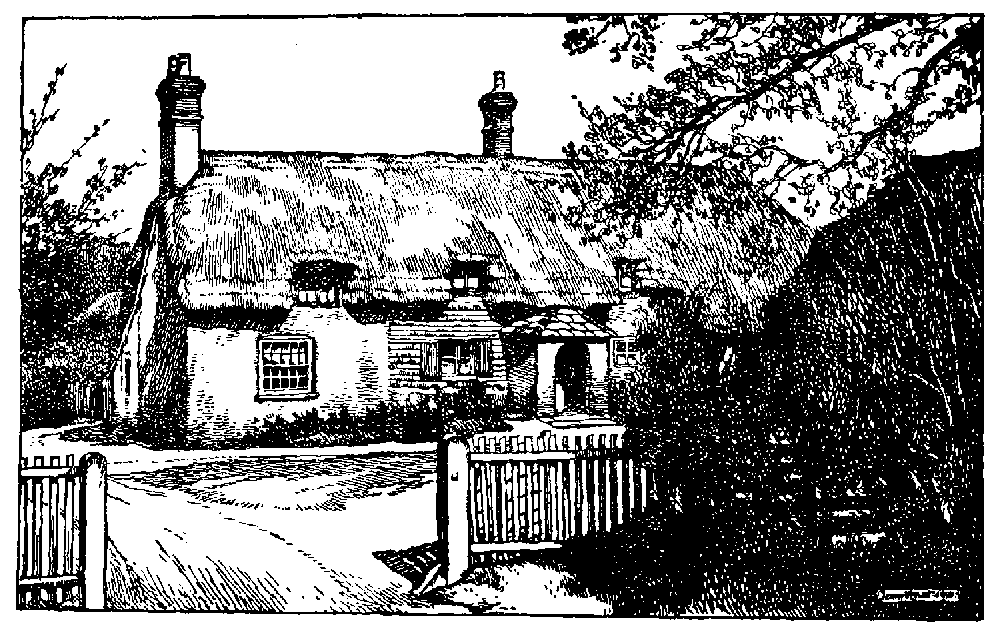
Ampress Farm, Lymington.
Borough
The borough of Lymington was a mesne borough held of the lords of the manor of New Lymington. It was apparently established under the charter of William de Redvers (1184–1216), (fn. 33) which is only known to us by a confirmation of his great-grandson Baldwin de Redvers (fn. 34) (1246–62). This Baldwin not only confirmed the charter of William de Redvers, but, as has been already mentioned, extended the borough on the north so as to include the Hundred Acres which it afterwards covered. In 1271 Isabella de Fortibus granted the burgesses a new charter, by which they obtained all such liberties and free customs, quittances and toll as free burgesses enjoyed throughout her land. (fn. 35) The borough, under this charter, was to be held at a yearly rent of 30s., and, further, the burgage rent was fixed at 6d. from the messuages both of the original borough and of the of 1688–9 by the mayor and burgesses, while 'the scot and lot men' at a rival election returned Thomas Jervoise and Thomas Cromwell. The mayor and burgesses refused to recognize the claim of the 'popular' candidates, who presented petitions in Parliament in 1690 and 1691. (fn. 36) In December of the latter year the Committee of Privileges reported that the Corporation of Lymington was a corporation by prescription and that the mayor and burgesses alone had the franchise. (fn. 37) To this the House agreed. In 1695 a second petition was presented with a like result, (fn. 38) and in 1710 the 'populace' made a last attempt to participate in the election, but their claim was disallowed. (fn. 39) Even at this date only fifteen or sixteen out of seventy burgesses were inhabitants of Lymington, (fn. 40) the rest being honorary burgesses whose chief and recognized function was to support the family in power at the Parliamentary elections. (fn. 41) From this time onwards the elections became not so much struggles between two political parties as between the adherents of the rival families of Burrard and Paulet. This may be illustrated by the events of 1745 when the mayor, a strong partisan, knowing that most of his opponents were away from Lymington, called a meeting and elected fourteen of his own party as burgesses. (fn. 42) The contest between the two families ended in an agreement by which the Burrards obtained the patronage on condition that the Paulet nominee was returned to the Parliament of 1774. (fn. 43) The Burrards further secured their position by first electing thirty-nine new burgesses and then by obtaining the re-enactment of by-laws limiting the number of burgesses to fifty, depriving the mayor of power to elect burgesses unless the number were under twenty and stipulating for six days' notice of a meeting of the burgesses. (fn. 44) From 1774 until 1832 the patronage of the borough was regarded as the private property of the Burrards, who at will elected burgesses 'in order to strengthen and support their family interest.' (fn. 45) In 1831 the constituency, which returned two members to Parliament, consisted only of thirty-eight electors. (fn. 46) With the reconstruction of the borough in 1835 (fn. 47) this state of affairs came to an end, but Lymington continued to return two members to Parliament until 1867. By the Representation of the People Act (fn. 48) it still retained one member until 1885, when by the Redistribution of Seats Act (fn. 49) its representation was merged in that of the New Forest division of the county.
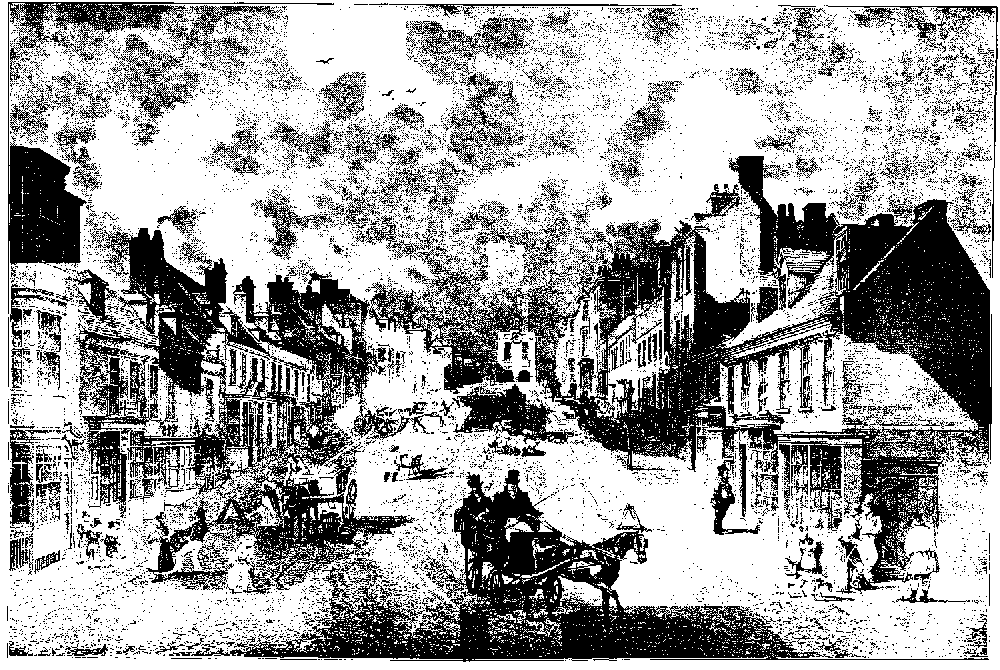
Lymington: High Street
(From an old print)
The earliest extant charter of Lymington contained a clause directing that no burgess should be made reeve of the borough but he who should be chosen by common consent and presented to the lord. (fn. 50) In 1269–70 Robert de Lisle (L'Isle) rendered account as reeve of the borough, and among the expenses of the year was 12d. paid to the reeve and bedel, an item also mentioned in 1271–4 and 1297–9. (fn. 51) The first mention found of the 'bailiffs and commonalty' occurs in a letter addressed by them to Edward I, (fn. 52) and they received writs under that style in 1308 (fn. 53) and 1346, (fn. 54) when they were ordered to prevent the bringing in of papal bulls or instruments prejudicial to the king. Though bereft of its glory the office of bailiff still existed in 1598, when the burgesses passed a resolution that none but burgesses should be elected to this office, an order that was afterwards cancelled. (fn. 55) In the 16th, 17th and 18th centuries the officers of the borough seem to have been much the same as in 1833, when they were a mayor, a recorder, a town clerk, a town Serjeant and burgesses to an indefinite number. (fn. 56)
A mayor is first mentioned by that name in the Town Books in 1508, when Robert Bishop held the office, and with the lord of the manor signed an agreement between the boroughs of Southampton and Lymington. (fn. 57) Like the bailiff, the mayor was chosen by the burgesses, the day of election being the Sunday after St. Matthew's Day, though from 1651 until the Restoration the date was changed to the Tuesday before Michaelmas (fn. 58); from early in the 19th century the election was made on the Monday following. (fn. 59) Before the reform of 1835 the burgesses met on that day and inspected the 'Record,' a list containing the names of the outgoing mayor and two other burgesses. They then struck off the Record the name of the mayor, who submitted to them the names of three burgesses suited to fill the vacancy; the burgesses had, however, power to elect an entirely new Record. If an individual burgess proposed a name of a burgess other than those named by the mayor, the mayor read out the whole list, and the Record was filled by a majority of votes. When the Record was completed the names upon it were submitted to the outgoing mayor and the burgesses, who by a majority of votes elected from among them the mayor for the ensuing year. In 1677, 'for the preventing of animosities and other inconveniences which may arise at the choice of a fit person to serve as mayor for this town,' the ballot was adopted; but six weeks later the burgesses concluded that the order was 'prejudicial and inconvenient,' and rescinded it accordingly. (fn. 60) The new mayor, generally the burgess whose name was last placed upon the Record, then attended the court leet, and, after paying homage, was sworn in and admitted to office. (fn. 61) In 1653 the court leet fined William Burrard £5 'for not taking upon him the office of mayor, as he was enioyned att the last lawday,' as well as £10 for not taking the oath of office. (fn. 62) An entry in the town books implies that before 1586 the 'rents, entries and forfeits' were claimed by the mayor as his emoluments; but in that year these were secured to the town, the mayor being granted 'the benefit of the wool' (fn. 63) until the expiration of the lease of Holme's Mead, (fn. 64) which he was then to have 'in respecte of the greate trouble and chardge he shall be put to by reasone of his sayde offyce.' (fn. 65) In 1599 the finances of the town were straitened by a dispute with certain 'disobedient persons,' and Holme's Mead was let, the mayor being compensated by a yearly sum of 50s. (fn. 66) This order was rescinded at a later date, and in 1833 the only emoluments of the mayor were one bushel of coals from each ship unloading at the port and sixpennyworth offish from each fishing boat. (fn. 67) The chief function of the mayor was the regulation of the tradeof Lymington as affected by its markets and fairs, quay and wharf. (fn. 68) He also acted as treasurer of the borough, and in 1584 the burgesses threatened that if he did not cause all forfeits to be paid in his year of office and accounted for at its end he would have 'to paye the same in that case of his owne purse.' (fn. 69)
The stewards are mentioned in 1584, when two burgesses were appointed to that office, (fn. 70) their duty being to collect the dues from the market and quay and account for them to the mayor. (fn. 71)
In 1596 a 'recorder' is mentioned, (fn. 72) though the borough possessed no courts. The name was probably assumed in emulation of other towns, for in 1698 'recorder' was used as synonymous with 'steward,' and in 1833, though the name 'steward' had disappeared, the recorder remained, without either functions or emoluments. (fn. 73) In practice the place of the stewards was taken by the town clerk, first mentioned in 1699. (fn. 74) In 1727 the burgesses 'ordered that the town clerk do receive the rents and do account for the same.' (fn. 75) The ale-taster was always a burgess, and held office for a year, his appointment being made at the time of the mayor's election. Although it is probable that an officer of the borough had been appointed ale-taster at a much earlier date, he is first mentioned in 1602, (fn. 76) and in 1652 the court leet fined Richard King 40s. for refusing the office. (fn. 77) The town serjeant held office at the pleasure of the mayor and burgesses, and is first mentioned in 1675, when 30s. were given him as his yearly wage, (fn. 78) a sum increased to 45s. in 1681. (fn. 79)
Of the origin of the Saturday market, which is still held in Lymington, no record remains, but the charter of Baldwin de Redvers speaks of the toll, while in 1269–70 the reeve of the borough rendered account of 30s. from the ferm of the toll and market. (fn. 80)
The right to hold a fair on St. Matthew's vigil, feast and morrow was granted by Henry III to Baldwin de Redvers in 1257, (fn. 81) and is mentioned in his grant to the borough. (fn. 82) In 1269–70 the reeve of the borough rendered no account from the tolls of the fairs, since the constable Hugh de Manby was answerable (fn. 83); shortly afterwards these tolls yielded 17s. 4½d., (fn. 84) though in 1297–9 the amount had dropped to 3s. 8d., (fn. 85) and the average in 1299–1300 was returned as 6s. 8d. (fn. 86) The stallage of the fair had been granted by Isabella de Fortibus to the burgesses in 1271, (fn. 87) and they claimed this with the picage in 1578, (fn. 88) when the fair was said to be held in the High Street. This fair is still held there on 2 and 3 October, but a second fair, said in 1578 to be also held in the High Street on the feast of St. Philip and St. James, has been discontinued during the last thirty years. (fn. 89)
Concerning the internal regulation of trade apart from the markets and fairs little information has been preserved, but the orders of 1584 forbade, under a penalty of 5s., the taking of a stranger as tenant without the mayor's consent. (fn. 90) That some further attempt was made to exclude aliens is evident from the further order of 1587, by which it was enacted that none 'shall use or occupye anie kinde of crafte occup'ion or trade within the Towne' without first compounding with the mayor. (fn. 91) In this connexion may also be mentioned an agreement made in 1594 by the mayor and burgesses and sundry butchers of the town, by which it was determined that all tallow should be delivered to John Pratt, the town chandler, at a fixed price of 2d. per lb., on the understanding that Pratt sold candles at 3s. per lb. to the inhabitants of the New Town and the burgesses living in the Old. (fn. 92)
The manor of Old Lymington undoubtedly owed its importance to its salterns, (fn. 93) the proximity of which must have greatly influenced the growth of the town; but while the tenants of the manor were labouring at their salterns it is evident that the burgesses were no less busily employed in faring over seas. The first known mention of the bailiffs and commonalty of Lymington occurs in their reply to the mandate of Edward I for the supply of three ships for his navy. (fn. 94) The larger ships, they said, were at sea and in the keeping of God, they had only little cogges left and these were not sufficient for war. However, they offered to furnish one large ship at their own cost for three weeks after the Assumption. (fn. 95) In 1324 the king demanded two ships instead of one from Lymington, 'Boldre' and 'Kyavene,' (fn. 96) and two years later Maurice de Brune and others were appointed to survey the ships of over 50 tons burden in the town of Lymington. (fn. 97) Some of the names of these merchantmen have been preserved. In 1349 Nicholas de Stok, a merchant of Norwich, and Thomas de Coventry, a merchant of Bristol, chartered the Rode Cog of Lymington, John de Ouse, master, to bring wine, mead, leather, canvas and other goods from Harfleur to England. (fn. 98) Again in 1342 a barge of Lymington was trading with wine and other merchandise between Brittany and Weymouth. (fn. 99) Salisbury seems to have looked upon Lymington as a convenient port, for in 1434 one of her merchants complained of the arrest of his ship the Marie of Lymington, (fn. 100) and in 1462 the citizens chartered the Trinity of the same port as their contribution to the fleet that put to sea under the Earl of Kent and Lord Audley. (fn. 101) It is not likely that the men of Lymington confined themselves to trade; acts of piracy, such as that committed by two men of Lymington in 1426 against the Christopher of Sluys belonging to John 'of Rows,' were doubtless frequent. (fn. 102)
During the Middle Ages Lymington would seem to have been particularly engaged in the wine trade, and the prosperity of the town in 1325 was such that the men of Southampton lodged a formal complaint with the Crown that whereas they had been granted all privileges as a port between Hurst and Langstone, in aid of their fee-farm, yet the men of Lymington had taken customs from certain ships putting in there. Southampton obtained a pronouncement from the courts in its favour, (fn. 103) but the complaint cropped up again and again. Thus in 1328 the town of Southampton declared that the men of Lymington had taken and carried away customs to the amount of £600, (fn. 104) and in 1330–1 two customers were appointed for the port of Lymington, (fn. 105) while a chief butler there is spoken of in 1334. (fn. 106) In 1346 there is record of the appointment of a king's yeoman for the port, (fn. 107) and in the same year masters of ships bringing in wine there were ordered to take security from the assignees 'that they would take the same to the accustomed places where the wines have been wont to be gauged.' (fn. 108) A petition was addressed to Parliament by 'the marchauntz and pooere inhabitauntz of the Havene of Lymyngton' in 1432, setting forth that in the past 'many divase shippes and vesselx with grete substaunce of merchaundises not staple ware but other were wont to put in there, but that of late there have been no customers, and the ships have therefore discharged elsewhere.' (fn. 109) The result of this was that the customers of Southampton were required to supply deputies for Lymington and for the collection of duty on goods other than staple. (fn. 110) The arrangement was not entirely satisfactory, and in 1508 the two towns agreed on a schedule of goods the duty on which was assigned to Southampton, while keelage, wharfage and other duties went to Lymington. (fn. 111) Disputes with Southampton on the collection of duty continued until 1730, when a judicial decision secured the petty customs to Lymington. (fn. 112) In the 17th century the carriage of New Forest timber formed an important item in the trade of the town, (fn. 113) and Lymington ships are mentioned as trading with Bordeaux, (fn. 114) and as carrying salt and hops to Ireland, (fn. 115) corn from Moran (fn. 116) and coal from Wales. (fn. 117)

Passford Farm, Lymington.
Manors
Domesday Book records that one Lening or Leving held 1 hide of land at LYMINGTON in parage under Edward the Confessor. Attached to this land was woodland which William annexed to the New Forest, and the assessment of the hide was lowered to half a hide in consequence, the value dropped at the same time from 20s. to 15s. The hide was granted to Earl Roger of Shrewsbury, (fn. 118) who held it in 1088, when Fulcuin was his tenant there. From Earl Roger Lymington descended, with his other lands, to his son Hugh Earl of Shrewsbury, who died in 1098, and was succeeded by his brother Robert. (fn. 119) On the accession of Henry I Robert took up the cause of Robert of Normandy, and in 1102 suffered forfeiture. (fn. 120) Lymington was then granted with Christchurch (q.v.) by Henry I (fn. 121) to Richard de Redvers, and like Christchurch (fn. 122) descended to Isabella de Fortibus, whose right to Lymington was attacked by the Prior of Breamore in 1267. The prior's claim was based on a grant made by the will of Baldwin, the late earl, who was buried in the priory. He also produced a charter given by Isabella herself confirming the gift and another confirmation made by Henry III on the testimony of Eleanor the queen. (fn. 123) Isabella admitted that Baldwin had granted the manor to Breamore Priory for a term of years, but since the prior had no seisin at the time of the earl's death the royal charter was of no avail. Her own charter of confirmation she maintained was exacted from her during the barons' wars, when she had remained loyal to the Crown in spite of the persistence of Simon de Montfort. After the battle of Lewes, while 'robbers and disturbers of the peace of the kingdom rode ravaging with horses and arms throughout England,' she had sought shelter at Breamore only to find in the prior a friend of Simon de Montfort the younger, to whom she had been 'sold seditiously' for 50 marks. In despair she had offered the charter upon the altar of the priory church of St. Michael of Breamore, and, the bribe proving successful, she was allowed to escape from the priory, though Simon de Montfort pursued her from place to place with horse and arms, desiring to capture her and seditiously abduct her until she found refuge in Wales. That Isabella's version was true may be inferred from the final agreement by which in return for £20 land in 'Portbyri' the prior acknowledged her right to the manor of Lymington, and returned to her the charters in dispute. (fn. 124) Avelina, the only daughter of the Countess Isabella, died in her mother's lifetime in 1274, and in 1293 the countess sold to the king the Isle of Wight with Christchurch and other manors. (fn. 125) On her death in the same year Edward I took the manor of Lymington, as a member of Christchurch, into his own hands, (fn. 126) and in 1299 he assigned it to Queen Margaret as part of her dower. (fn. 127) In 1302, however, Henry Courtenay, cousin and heir (fn. 128) of Isabella, successfully claimed the manor of Lymington, maintaining that it had never been a member of Christchurch Twyneham and was not included in the grant to the Crown. (fn. 129) In 1315 Hugh was empowered to enfeoff his mother Eleanor, daughter of Hugh Lord le Despenser, in the manors of Old and New Lymington, (fn. 130) and he was returned as lord in 1316. (fn. 131) Hugh Courtenay died in 1340 and was succeeded by his son of the same name, (fn. 132) who in the following year had livery of the 'manor of Bremmore and Lymington . . . held in chief' by the service of two knights' fees, (fn. 133) New Lymington being assessed in 1346 at half a fee. (fn. 134) Hugh died in 1377 and was succeeded by his grandson Edward, (fn. 135) who in 1385 received licence to grant messuages, land and rent in Old and New Lymington to feoffees. (fn. 136) Dying in 1419 he was succeeded by his son Sir Hugh Courtenay, (fn. 137) and he in 1422 by his son Thomas, then a child but eight years old. (fn. 138) In the Wars of the Roses Thomas Courtenay remained a firm Lancastrian, and his principles were inherited by his son Thomas, who succeeded his father in 1458, (fn. 139) and, being made prisoner at the battle of Towton, was beheaded in April 1461. (fn. 140) Lymington, with his other lands, was confiscated, (fn. 141) but in the July of the same year his brother Henry received licence to enter freely into the manor of Lymington, (fn. 142) and in the following February Edward IV granted him the manor and borough, confirming them to him in 1465. (fn. 143) However, after the death of Henry in 1467 the king granted Lymington to Walter Blount (fn. 144) created Lord Mountjoy in 1465. (fn. 145) He died in 1474 and was succeeded by his son Edward, then a child of seven years (fn. 146); the close of his minority must almost have coincided with the accession of Henry VII, who in October 1489 restored Lymington to Edward Courtenay as heir of Henry, the grant being afterwards allowed by Parliament. (fn. 147) As Edward died childless, the manors passed to his sister Joan wife of William Knyvet, and on her death without issue to her sister Elizabeth, who had married Sir Hugh Conway, kt. Possession of the manors was confirmed to them in 1490, but they too were childless. (fn. 148) In 1511 Henry VIII granted the reversion of the manors to William Courtenay Earl of Devon and Katherine his wife, (fn. 149) sixth daughter of Edward IV, but William died shortly afterwards and the grant was confirmed to Katherine in 1512. (fn. 150) From her it descended in 1527 to her son Henry created Marquess of Exeter in 1511, (fn. 151) and it was among the possessions confiscated on his attainder and execution in 1539. (fn. 152) Lymington remained in the hands of the Crown until 1541, when it formed part of the jointure of Katherine Howard. (fn. 153) On her execution it was once more forfeited and granted by Edward VI in 1553 (fn. 154) to his uncle, Sir Henry Seymour, kt. One of the first acts of Queen Mary was to release Edward Courtenay Marquess of Exeter, who had been imprisoned in the Tower since the execution of his father, and Lymington was restored to him in May 1554. (fn. 155) He died unmarried at Padua in 1556 and Lymington again came into the hands of the Crown. (fn. 156) Portions of it were leased in 1589 and 1590; in 1593 it was granted for a term to Thomas and William Fortescue and seven years later it was granted in fee to Nicholas Lord Zouche and Elizabeth his wife. (fn. 157) The latter in 1601 conveyed Lymington to Charles Earl of Nottingham and Katherine his wife, (fn. 158) who held it for less than eight years, Abraham Campion, citizen and cloth-maker of London, being the lord in 1609. (fn. 159) He died in London in 1611 (fn. 160) and was succeeded by Henry, his son, and Lymington is said to have been held by his descendants in 1664. (fn. 161) However, in 1665 Bartholomew Bulkeley was in possession (fn. 162) and was succeeded by a son of the same name, whose son Thomas was followed by a son Bartholomew. (fn. 163) In 1733 the manor was in the hands of Thomas Missing, (fn. 164) who, with Thomas Marday and James Missing, conveyed it in 1778 to Clewer Stares. (fn. 165) Mrs. Elizabeth Gwitton had become lady of the manor by 1785–90 (fn. 166) and was still holding it in 1795 (fn. 167); but in 1805 she sold it to George Bishop of Lincoln and afterwards of Winchester. In 1834 the bishop's eldest son William Edward Tomline, sometime M.P. for Truro, sold it to John Pulteney, who died in 1849, having by his will devised this manor and his other estates to uses under which his grandson John Granville Beaumont Pulteney became tenant for life. Mr. J. G. B. Pulteney died in 1875, leaving an only son, Mr. Keppel Pulteney, the present lord of the manor. (fn. 168)
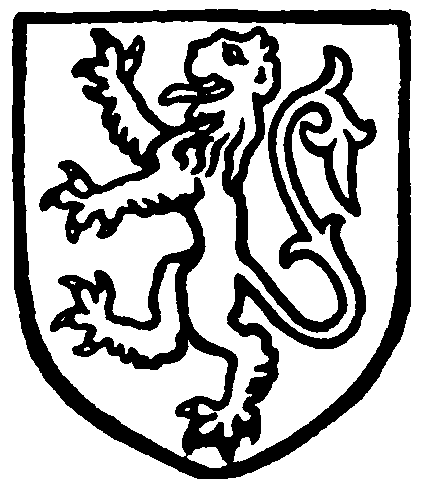
Redvers. Or a lion azure.
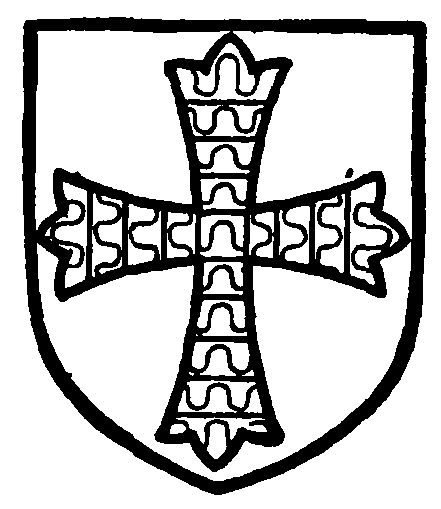
De Fortibus. Gules a cross paty vair.
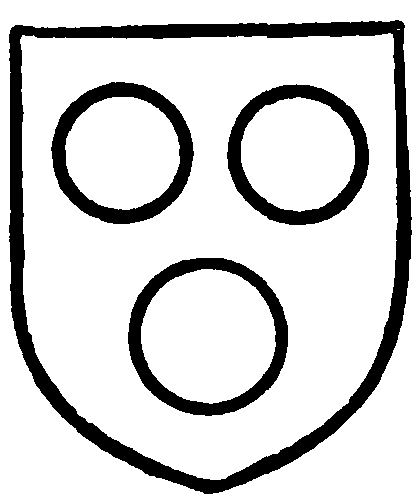
Courtenay. Or three roundels gules.
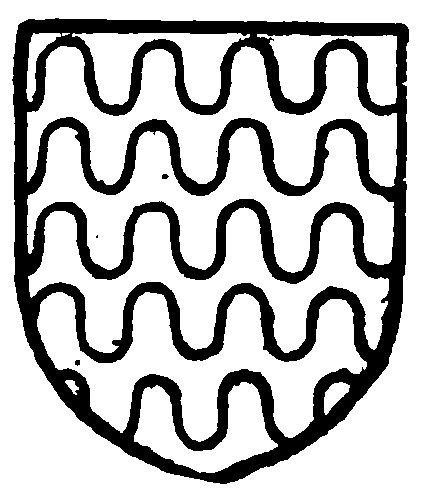
Blount, Lord Mountjoy. Barry wavy or and sable.
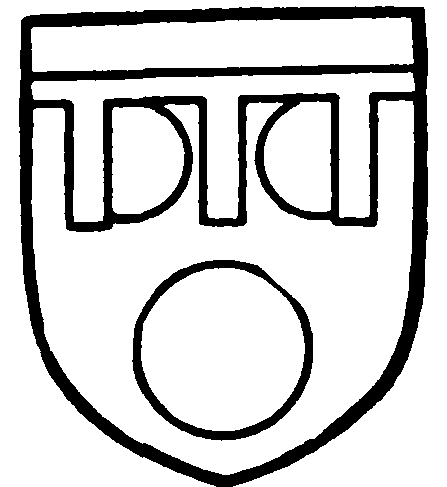
Courtenay, Earl of Devon. Or three roundels gules and a label azure.

Campion. Argent a chief gules with an eagle or therein.
The manor of NEW LYMINGTON followed the descent of the older manor, and is practically conterminous with the borough.
As a member of the manor of Old Lymington the overlordship of BUCKLAND (Boclande, xiii cent.) followed the descent of that manor (q.v.). (fn. 169) Its recorded history begins in the 13th century when Nigel de Buckland with the consent of Nigel his son and heir granted a saltern to the monks of Quarr in the marsh of Oxeheye; this was probably in the early years of the century, for in 1299–1300 John de Buckland, apparently a son of the younger Nigel, (fn. 170) was holding 28 messuages, a water-mill and a saltern of the manor of Old Lymington. (fn. 171) In 1316 William de Percy, possibly a trustee, granted to this same John 2 carucates of land, 45 acres of meadow, 57 acres of pasture in Buckland, Arnewood and other places. (fn. 172) Before 1340 John had been succeeded by William de Buckland, who in that year made a settlement of the land on himself and his wife Joan with remainder to Robert, their son and heir.' (fn. 173) Robert probably died before his father, or could only have held the manor a short time, since in 1362 (fn. 174) a Sir John de Buckland died seised of the manor, assessed at one eighth part of a fee, leaving a brother and heir Thomas.
A few years afterwards it must have come into the hands of Walter Sydelyng, who died before 1397, (fn. 175) leaving two daughters and co-heirs, Margery, who married John Durneford, and Amflesia, who married Thomas Colyngton, to whom the manor descended in two moieties. (fn. 176) Both John and Margery Durneford had died childless before 1413, (fn. 177) when Thomas Colyngton also died, having survived his wife, whose heir was her cousin Agnes daughter of Emmote the sister of Walter de Sydelyng. (fn. 178) The two moieties of the manor thus became united in the hands of Agnes, then a woman of fifty, (fn. 179) and possibly married to a member of the Popham family, for in 1417 it was held by Henry Popham, who before his death in that year had settled it on his younger son John Popham, (fn. 180) and in 1444–5 certain trustees demised the whole manor to Margaret widow of Henry Popham. (fn. 181)
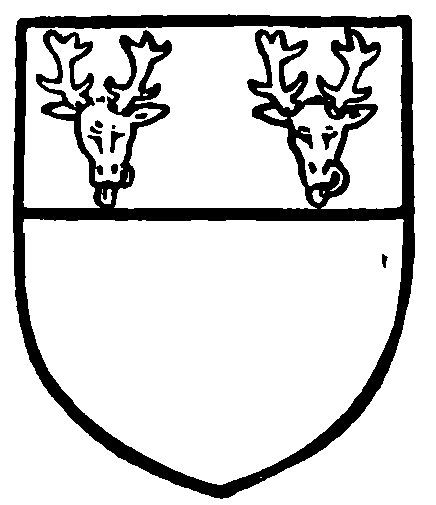
Popham. Argent a chief gules with two harts' heads caboshed or therein.
Shortly after this the manor seems to have been again divided into two moieties through the succession of co-heiresses. In 1473 a John Long died seised of the manor of Barton Stacey (q.v.) and half the manor of Buckland in right of Margaret his wife. (fn. 182) He was succeeded by Thomas his son, and he in 1497 sold this moiety of the manor to John Long, (fn. 183) who in his turn dealt with it by fine in 1567. (fn. 184) In 1601 he sold it to Sir Walter Long, (fn. 185) mentioned as lord of half the manor of Buckland in 1609. He died in 1611 and was succeeded by Walter, his son, then a minor, (fn. 186) who was still holding the land in 1621, when he was party with John Long to a settlement. (fn. 187)
The second moiety of the manor was held in 1524 by Sir Thomas Lovell, kt., (fn. 188) who by his will bequeathed it to Thomas Manners Lord Roos in tail male. In 1534 Richard Colville and others conveyed it to Matthew Hardys. (fn. 189) Ten years later it was in the hands of William Kellaway and Anne his wife, (fn. 190) whose daughter Mary married William Button of Alton and brought this moiety into that family. (fn. 191) They were succeeded by their eldest son Sir Ambrose Button, (fn. 192) who held it in 1609. (fn. 193) Settlements were made of the manor on their younger sons Edward and Henry Button, with contingent remainders to their nephew John son of John Button and others. Both Edward and Henry died without male issue, and in 1624 the succession passed in accordance with the settlement. (fn. 194) The fourth John Button of Buckland died without issue in 1679, when his lands were divided between his sisters and co-heirs, Anne wife of Paul Burrard, Cecilia wife of William Knapton and Elizabeth wife of John Burrard. (fn. 195)
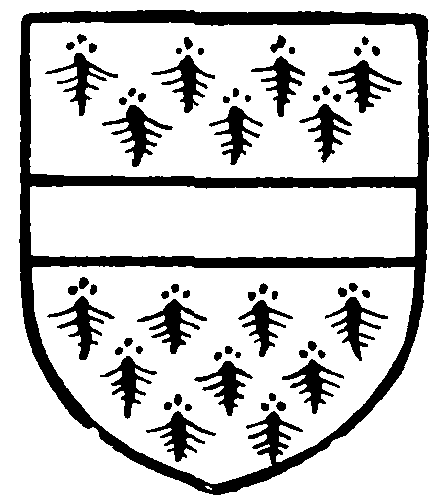
Button. Ermine a fesse gules.
The heritage of Elizabeth was further divided between her daughters and co-heirs: Mary who married Robert Knapton, Sarah, who married Hugh Harsnet, and Betty wife of Ralph Hastings. (fn. 196) It was their children who conveyed some rights in the manor to George Midleton in 1713. (fn. 197) In 1705 the entirety of the manor passed to William son of Cecilia and William Knapton. (fn. 198) His trustees in 1716 conveyed it to Edward Dummer, who left coheiresses, one of whom was Mary wife of John Bond. In 1775 the co-heiresses made a conveyance under which John son of Mary and John Bond ultimately became tenant in tail of the manor. John Bond lived at Buckland in 1790 and in 1802 sold lands in Buckland, but not the manor, to George Tomline. These lands have followed the descent of the manor of Lymington and are now owned by Mr. Keppel Pulteney. The old manor-house known as Little Buckland was sold by Mr. Pulteney to Captain Cotton, the present owner, in 1895.
Church
The church of ST. THOMAS OF CANTERBURY consists of chancel with continuous nave, north chapel, transepts, and aisle with a north porch, containing a stair to the gallery above, a tower south-west of the chancel, a south aisle with gallery and a west gallery approached by a stair from a passage and doorway at the west end. There is little of real architectural interest, but the north chapel dates from the end of the 13th century, and the chancel, retaining a mid-13th-century piscina, is doubtless older. Traces of an arcade discovered in its south wall show that it had a south chapel also, and the north transept is probably on old lines. All other evidence of ancient work is destroyed, but enough remains to show that the church was of considerable size and importance by the end of the 13th century.
The present tower dates from 1670, and possibly represents an earlier one in this position. The nave and aisles appear to be entirely of the 18th century or later. Records of work done in 1682, 1756 and 1792 give the dates for these works, but in modern times most of the windows have been fitted with Gothic tracery, and the general external effect is that of a much-restored Gothic building.
The east window of the chancel is modern of five lights in 15th-century style. On the south wall is a trefoiled piscina recess of 13th-century date, with a well-moulded arch and shafted jamb and two modern three-light windows.
The rear arches and jambs of the east and two north windows of the north chapel are original and of very good detail, with moulded labels, and in the case of the east window engaged shafts in the jambs. The pair of buttresses on the north-east angle are also original, but the window tracery is entirely modern.
The window in the north transept is modern, of three lights, and has some very poor foreign stained glass representing the nailing of Christ to the cross. West of this in the north aisle are three modern twolight windows.
The interior is full of galleries; a large one at the west containing the organ, another in the south aisle, and a third running the full length of the church, from the east wall of the north chapel to the west end of the nave. All have panelled wood fronts, and are carried on pairs of plastered columns, with similar pairs above them to support the roofs. The principal entrances to the church are under the tower and at the west of the nave, and over the latter is a five-light window with modern tracery of 15th-century style.
The roofs of the chancel, nave, north chapel and transept are of a mediaeval type common in the district, with arched plaster ceilings divided into panels by thin moulded ribs, with carved bosses at the intersections. On the chancel roof is the date 1720, and some cherubs' heads at the east end are certainly of this time, but in the main the roof must be old work repaired. The bosses are crudely coloured, and in themselves are of very poor workmanship; but some seem mediaeval, and this is notably the case in the north transept, where the Trinity emblem of the three fish in triangle occurs, as well as an angel holding a shield with its lettering in late Gothic. Much of the work looks to be 18th-century imitations of 15th-century details. The altar table is dated 1673, with the initials I. K. P. W., but there are otherwise no old wood fittings, and the font is comparatively modern. The only monument of interest is a small brass to Joan wife of Francis Guidott, whose death on Christmas Day is thus recorded, 'Natale Christi cum Christo celebravit. Anõ D[omi]ni 1668.' On a shield is Guidott Party saltirewise nebuly or and azure with two crescents gules in the or and a chief azure with a leopard between three fleurs de lis or therein quartering Party a griffon counter-coloured in an engrailed border.
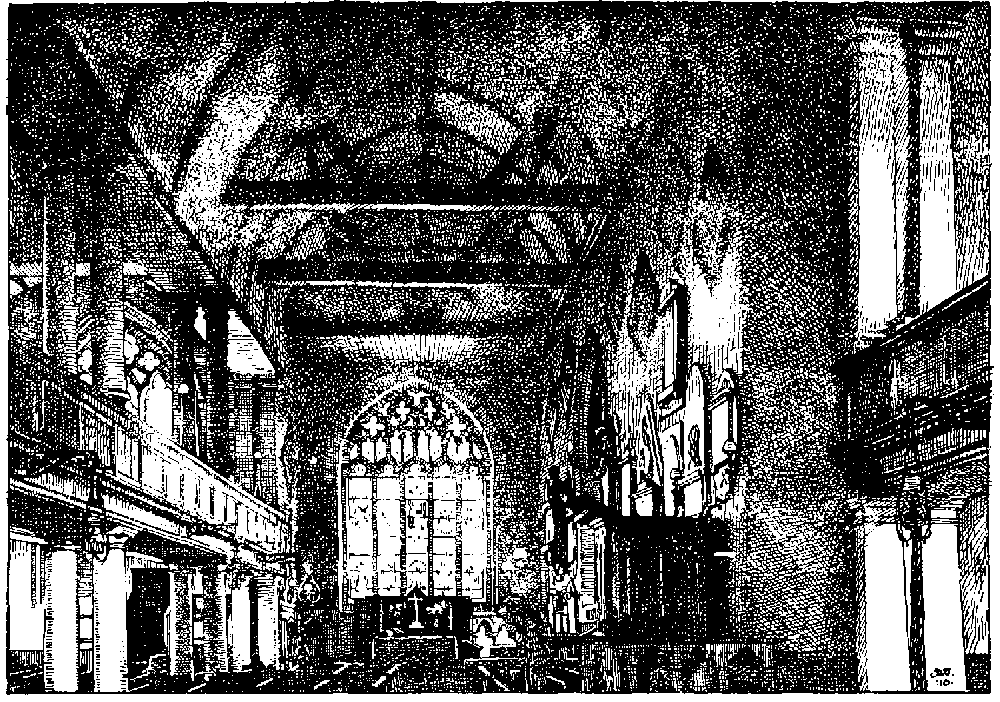
Lymington Church, Interior
There are nine funeral hatchments and many late mural monuments throughout the church.
On the stair at the west end are the royal arms of George I, dated 1716.
There are eight bells.
The plate consists of two silver chalices, of 1774 and 1840 respectively, two silver patens of 1774 and one of 1840, and a flagon and two almsdishes of Sheffield plate, one of the latter bearing the date 1806.
The registers are contained in seven books. Book 1 has all entries, 1662 to 1709 (incomplete to 1683); 2, the same, 1709 to 1754; 3, baptisms and burials, 1754 to 1812; 4, 5, 6, and 7, marriages only, 1754 to 1764, 1764 to 1772, 1772 to 1785, and 1785 to 1812 respectively. There are also two volumes of churchwardens' accounts, 1669 to 1797; vestry minute books, 1738 to 1812; and a minute book of poor-house committee, 1775 to 1790.
Advowson
The earliest known record of a chapel at Lymington is in a charter of 1141–55 by which Baldwin de Redvers granted to Christchurch Twyneham the church of Boldre, with its chapels of Brockenhurst and Lymington. (fn. 199) The right of presenting a chaplain to the chapel probably belonged to the vicar of Boldre from the first; at the close of the 16th century it was still the custom for the churchwardens and inhabitants of Lymington to go to Boldre on Midsummer Day and render a wax taper and 3s. to the churchwardens there, in consideration of a dinner for the two priests, clerks and choristers. (fn. 200) The tithes were also paid to the vicar, who appears to have paid the salary of the chaplain, though the amount does not appear. In 1657, on the petition of the mayor and burgesses, the Commonwealth Council ordered the trustees for the maintenance of ministers to allow the minister of Lymington an augmentation of £50. (fn. 201) In the early 19th century the practice was for the vicar of Boldre to nominate a curate and for the parishioners to present, (fn. 202) but in 1870 the chapelry of St. Thomas of Canterbury was erected into a vicarage, the Bishop of Winchester being patron.
The chantry of St. Edward the Bishop at Buckland is first mentioned in 1396–7 when the advowson was granted with 2 carucates of land by Edward Courtenay to John and Margery Durneford. (fn. 203) It was held by the successive owners of the second moiety of the manor, being in the hands of Richard Colville in 1534 (fn. 204) and in those of Sir William Kellaway ten years later, (fn. 205) when it is last mentioned. About this date it is called a free chapel, founded for a priest to sing for the ease of the tenants there. The value of the chapel was 66s. 8d., which the priest received as salary, and it was said that there were no ornaments, plate, jewel goods or chattels appertaining thereto. (fn. 206) It seems, however, to have been endowed with some land, for in 1609 it was stated that the only land round Buckland Common not belonging to Buckland was the 'Chauntrie' Close. (fn. 207)
The Roman Catholic chapel of Our Lady of Mercy and St. Joseph was built in 1859. There are also a Baptist chapel, founded in 1688, a Congregational chapel, founded in 1700, a Wesleyan Methodist chapel and the Salvation Army have a meeting place.
Charities
Fulford's School, founded by George Fulford by deed, 1668. (fn. 208) —In addition to land and buildings, the school is endowed with £156 17s. 3d. consols, with the official trustees, who also hold a sum of £313 14s. 6d. consols, representing a legacy of £300 by will of Ann Burrard, bearing date 4 July 1777. The income is applied in support of the National school, conveyed by deed 1835.
Charity of Thomas Brown (see under Christchurch).—The share applicable in Lymington amounts to about £12 10s. a year, of which 10s. is paid to the minister for preaching a sermon on 1 January, and the residue is applicable in clothes, bread or otherwise.
In 1721 George Burrard, by will proved in the P.C.C., gave to the poor £100 to be laid out for their benefit. The principal was originally laid out in the erection of almshouses, subsequently added to the poor-house. Under order of the Poor Law Board, 1853, a sum of £130 was invested in £143 8s. 11d. consols in respect of this charity.
Rear-Admiral Thomas Rogers, who died in 1814, by his will bequeathed £1,000, the income thereof to be applied for the benefit of ten old and indigent men and women, five of each sex. The trust fund consists of £1,082 4s. 10d. consols, producing yearly £27 1s., which is divided equally among the ten recipients.
Howe's Charity.—In 1868 Lieut. Thomas Rogers, R.N., by will proved at Oxford 27 May, bequeathed £2,100 consols, to found a charity to be called after his wife, the income to be distributed on 21 October in every year in overcoats, cloaks or blankets amongst poor men and women attending church, the minister to receive £1 and the churchwardens 10s. each. The stock is held by the official trustees. In 1906 44 persons received £1 each.
Nonconformist Charities:—
The Congregational Church Endowments—The official trustees hold the trust funds following, namely:—
£544 0s. 11d. India 3 per cent, stock, income applicable under deed of 6 November 1787 in defraying expenses; £500 13s. 11d. like stock, income applicable under deed of 2 August 1890 in maintenance, clothing and education of poor children belonging to Presbyterian congregation, residue for poor of same; £255 India 3½ per cent. stock, arising from gifts of Sarah Jefferey and Ann Burrard, by deeds, dated respectively 2 May 1745 and 1 June 1787, for the minister, and £391 6s. 1d. India 3 per cent. stock, also for the minister, under will of Charles Rice dated 23 February 1854. See also under East Boldre.
The New Lane Baptist Chapel, founded in 1688, is endowed with a house in New Street, a garden in Gosport Street containing 3a. 3r. 15p., and 5a. 1r. 6p. of meadow-land, producing yearly £70 or thereabouts, applicable under deeds of 1792 and 1878 towards the pastor's stipend and repairs. In 1883 Robert Wheeler, by will proved at London 9 March, bequeathed £10,000 consols, the dividends of which are applicable in the payment of £50 to the minister of the same chapel, and the residue for poor widows, children and indigent poor members of the congregation. The stock is held by the official trustees.
